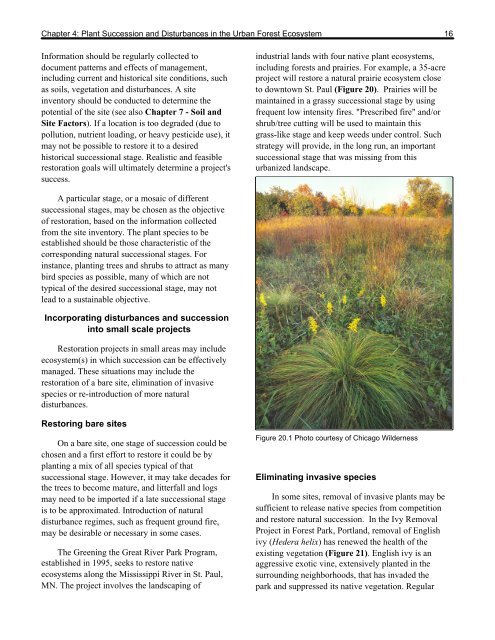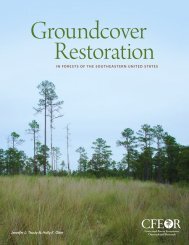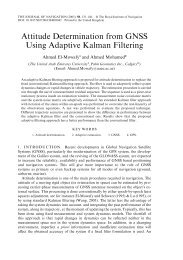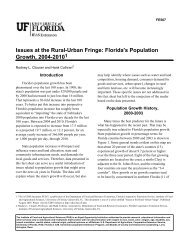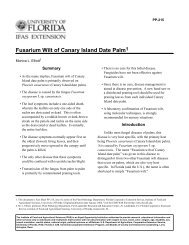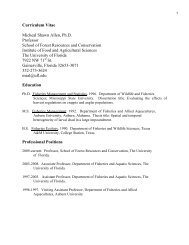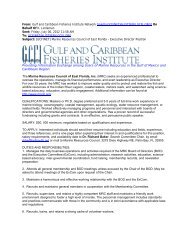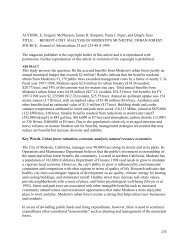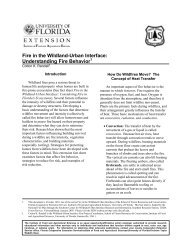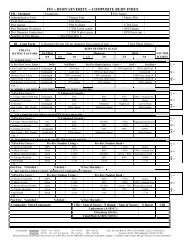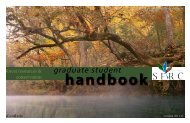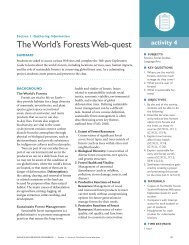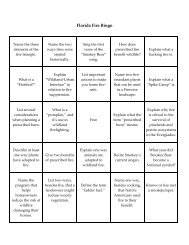Chapter 4: Plant Succession and Disturbances in the Urban Forest ...
Chapter 4: Plant Succession and Disturbances in the Urban Forest ...
Chapter 4: Plant Succession and Disturbances in the Urban Forest ...
You also want an ePaper? Increase the reach of your titles
YUMPU automatically turns print PDFs into web optimized ePapers that Google loves.
<strong>Chapter</strong> 4: <strong>Plant</strong> <strong>Succession</strong> <strong>and</strong> <strong>Disturbances</strong> <strong>in</strong> <strong>the</strong> <strong>Urban</strong> <strong>Forest</strong> Ecosystem 16<br />
Information should be regularly collected to<br />
document patterns <strong>and</strong> effects of management,<br />
<strong>in</strong>clud<strong>in</strong>g current <strong>and</strong> historical site conditions, such<br />
as soils, vegetation <strong>and</strong> disturbances. A site<br />
<strong>in</strong>ventory should be conducted to determ<strong>in</strong>e <strong>the</strong><br />
potential of <strong>the</strong> site (see also <strong>Chapter</strong> 7 - Soil <strong>and</strong><br />
Site Factors). If a location is too degraded (due to<br />
pollution, nutrient load<strong>in</strong>g, or heavy pesticide use), it<br />
may not be possible to restore it to a desired<br />
historical successional stage. Realistic <strong>and</strong> feasible<br />
restoration goals will ultimately determ<strong>in</strong>e a project's<br />
success.<br />
<strong>in</strong>dustrial l<strong>and</strong>s with four native plant ecosystems,<br />
<strong>in</strong>clud<strong>in</strong>g forests <strong>and</strong> prairies. For example, a 35-acre<br />
project will restore a natural prairie ecosystem close<br />
to downtown St. Paul (Figure 20). Prairies will be<br />
ma<strong>in</strong>ta<strong>in</strong>ed <strong>in</strong> a grassy successional stage by us<strong>in</strong>g<br />
frequent low <strong>in</strong>tensity fires. "Prescribed fire" <strong>and</strong>/or<br />
shrub/tree cutt<strong>in</strong>g will be used to ma<strong>in</strong>ta<strong>in</strong> this<br />
grass-like stage <strong>and</strong> keep weeds under control. Such<br />
strategy will provide, <strong>in</strong> <strong>the</strong> long run, an important<br />
successional stage that was miss<strong>in</strong>g from this<br />
urbanized l<strong>and</strong>scape.<br />
A particular stage, or a mosaic of different<br />
successional stages, may be chosen as <strong>the</strong> objective<br />
of restoration, based on <strong>the</strong> <strong>in</strong>formation collected<br />
from <strong>the</strong> site <strong>in</strong>ventory. The plant species to be<br />
established should be those characteristic of <strong>the</strong><br />
correspond<strong>in</strong>g natural successional stages. For<br />
<strong>in</strong>stance, plant<strong>in</strong>g trees <strong>and</strong> shrubs to attract as many<br />
bird species as possible, many of which are not<br />
typical of <strong>the</strong> desired successional stage, may not<br />
lead to a susta<strong>in</strong>able objective.<br />
Incorporat<strong>in</strong>g disturbances <strong>and</strong> succession<br />
<strong>in</strong>to small scale projects<br />
Restoration projects <strong>in</strong> small areas may <strong>in</strong>clude<br />
ecosystem(s) <strong>in</strong> which succession can be effectively<br />
managed. These situations may <strong>in</strong>clude <strong>the</strong><br />
restoration of a bare site, elim<strong>in</strong>ation of <strong>in</strong>vasive<br />
species or re-<strong>in</strong>troduction of more natural<br />
disturbances.<br />
Restor<strong>in</strong>g bare sites<br />
On a bare site, one stage of succession could be<br />
chosen <strong>and</strong> a first effort to restore it could be by<br />
plant<strong>in</strong>g a mix of all species typical of that<br />
successional stage. However, it may take decades for<br />
<strong>the</strong> trees to become mature, <strong>and</strong> litterfall <strong>and</strong> logs<br />
may need to be imported if a late successional stage<br />
is to be approximated. Introduction of natural<br />
disturbance regimes, such as frequent ground fire,<br />
may be desirable or necessary <strong>in</strong> some cases.<br />
The Green<strong>in</strong>g <strong>the</strong> Great River Park Program,<br />
established <strong>in</strong> 1995, seeks to restore native<br />
ecosystems along <strong>the</strong> Mississippi River <strong>in</strong> St. Paul,<br />
MN. The project <strong>in</strong>volves <strong>the</strong> l<strong>and</strong>scap<strong>in</strong>g of<br />
Figure 20.1 Photo courtesy of Chicago Wilderness<br />
Elim<strong>in</strong>at<strong>in</strong>g <strong>in</strong>vasive species<br />
In some sites, removal of <strong>in</strong>vasive plants may be<br />
sufficient to release native species from competition<br />
<strong>and</strong> restore natural succession. In <strong>the</strong> Ivy Removal<br />
Project <strong>in</strong> <strong>Forest</strong> Park, Portl<strong>and</strong>, removal of English<br />
ivy (Hedera helix) has renewed <strong>the</strong> health of <strong>the</strong><br />
exist<strong>in</strong>g vegetation (Figure 21). English ivy is an<br />
aggressive exotic v<strong>in</strong>e, extensively planted <strong>in</strong> <strong>the</strong><br />
surround<strong>in</strong>g neighborhoods, that has <strong>in</strong>vaded <strong>the</strong><br />
park <strong>and</strong> suppressed its native vegetation. Regular


